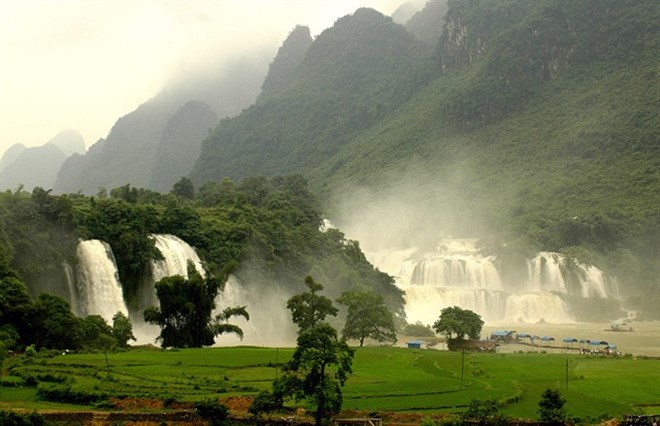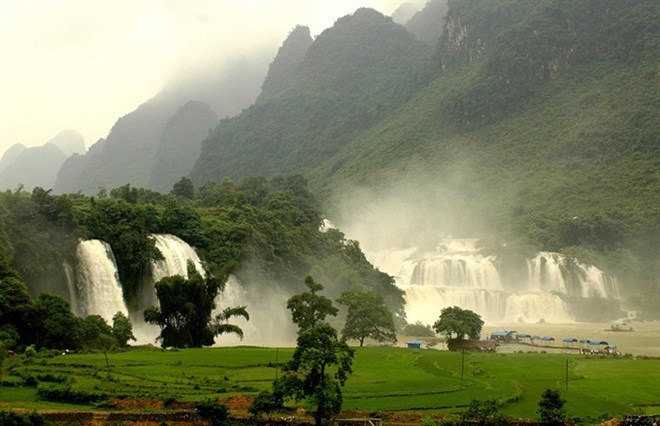
The People’s Committee of Cao Bang province and the Ministry of Construction on August 17 announced master and detailed plans for developing Ban Gioc waterfall tourist site.

Ban Gioc Waterfall (Photo:
VNA)
The announcement aims to
call for investment from enterprises to turn Ban Gioc waterfall tourist site
into a key tourism site of the northern mountainous province and the nation,
contributing to boosting the development of the province and the region.
Under the master plan, approved by the Prime Minister in April this year, the
Ban Gioc waterfall tourist site will cover 1,000ha while the central area of
the site will cover 156.7ha.
Facilities will be also built in the zone to serve tourism, including hotels
and service areas.
The tourist site is expected to welcome approximately 750,000 visitors per year
and have more than 1,000 rooms for tourists by 2020. By 2030, the tourist site
is estimated to receive 1.2 million visitors and have some 1,750 rooms for
visitors.
The central area of the Ban Gioc waterfall tourist site is set to have four
areas including the Ban Gioc waterfall landscape, the landscape along the Quay
Son River, the mountainous forestry landscape ecology and the agricultural
landscape ecology.
Ban Gioc is in Dam Thuy commune, Trung Khanh district, on the border with
China’s Guangxi province. It is
53 metres high and
300 metres wide and has
three levels of smaller waterfalls.
The waterfall is the fourth largest border waterfall in the world and was named
one of the ten most spectacular waterfalls in the world by travel site
Touropia.
In 2016, the tourism site welcomed more than 178,000 visitors.
Source:VNA
Spanning thousands of hectares and winding gracefully along mountain slopes, hillsides, and riverbanks, the terraced rice fields of Lac Son District present a stunning and captivating beauty. This region, renowned for its remarkable terraced landscapes, is also the centre of Hoa Binh Culture known for numerous archaeological sites.
The life of Mong people in Hang Kia and Pa Co communes of Mai Chau district has improved much thanks to tourism development.
The man-made Hoa Binh Lake, with a water surface area of approximately 9,000 hectares and a capacity of 9.45 billion cubic meters, stretches over 200 kilometers from Hoa Binh to Son La provinces. With the goal of developing into a national tourism area, the Hoa Binh Lake tourism area is expected to not only become the largest tourism centre in the province but also one of the 12 key tourist destinations in the northern midland and mountainous region of Vietnam.
Da Bia hamlet, now Duc Phong, in Tien Phong commune, Da Bac district, was once almost isolated from the outside as the only way to the hamlet was to get a boat ride across the Hoa Binh reservoir. However, as its tourism potential has been unleashed, the hamlet has established itself as one of the most attractive destinations on the tourism map. It has even received the ASEAN Community-Based Tourism Awards in 2019.
In the first 9 months of 2024, Mai Chau district, Hoa Binh province welcomed over 684 thousand visitors to visit and relax. In which, over 516 thousand domestic visitors and more than 168 thousand international visitors. Total revenue from tourism is estimated at over 821 billion VND.
Da Bac district, bestowed with stunning landscapes, is developing ecological and resort tourism offerings. Several tourist sites, put into operation this year, has attracted throngs of high-spending and young domestic visitors.



